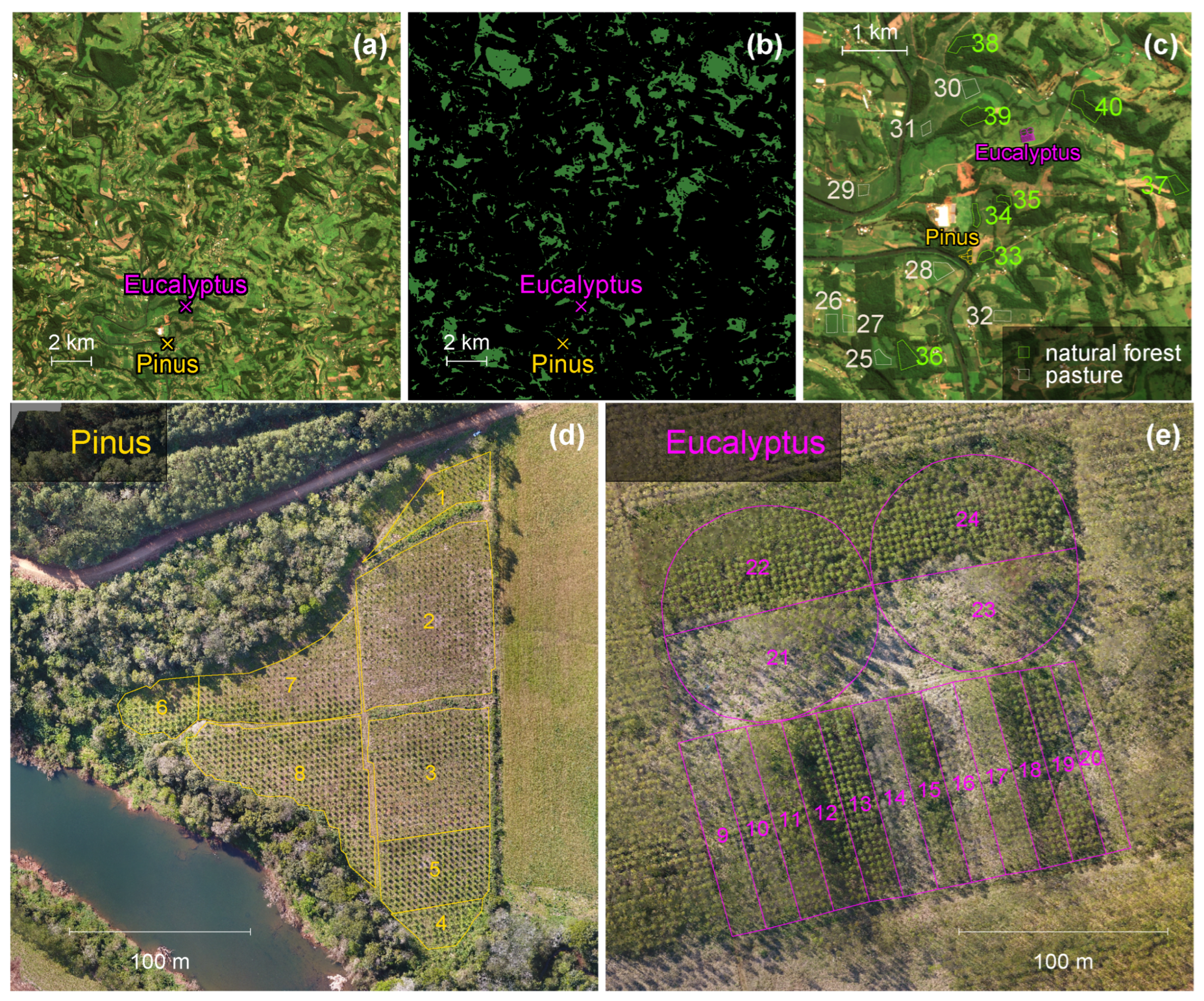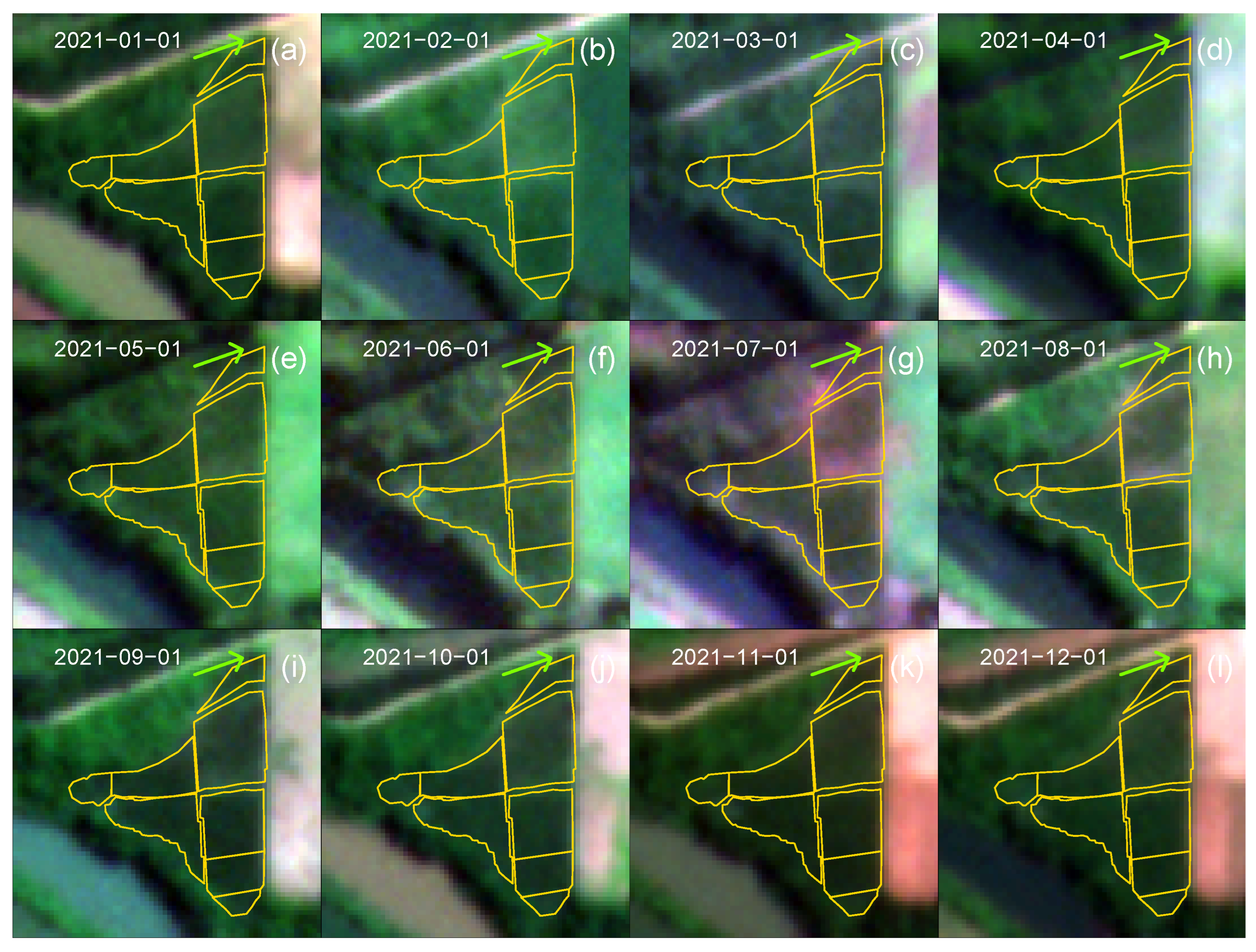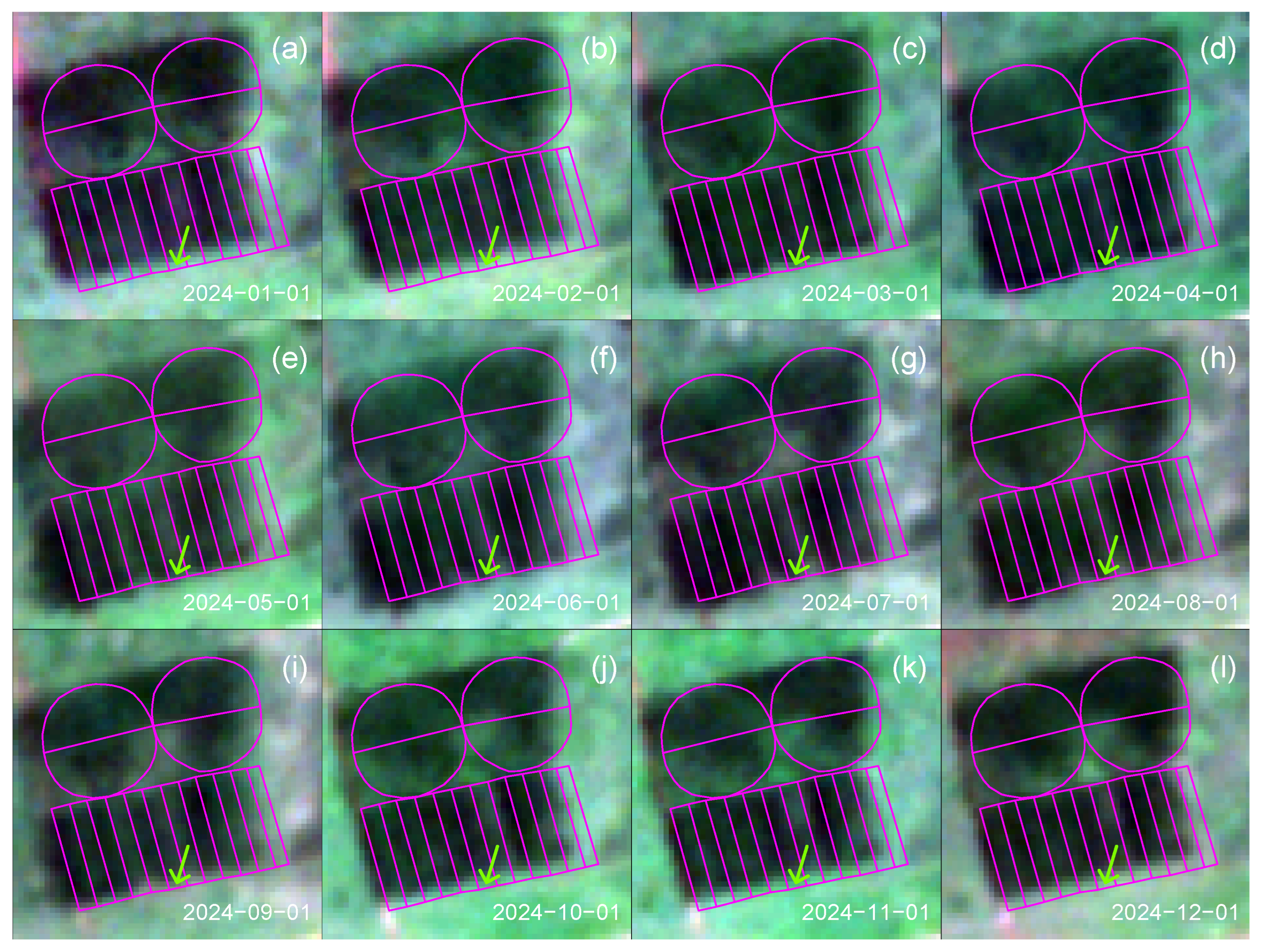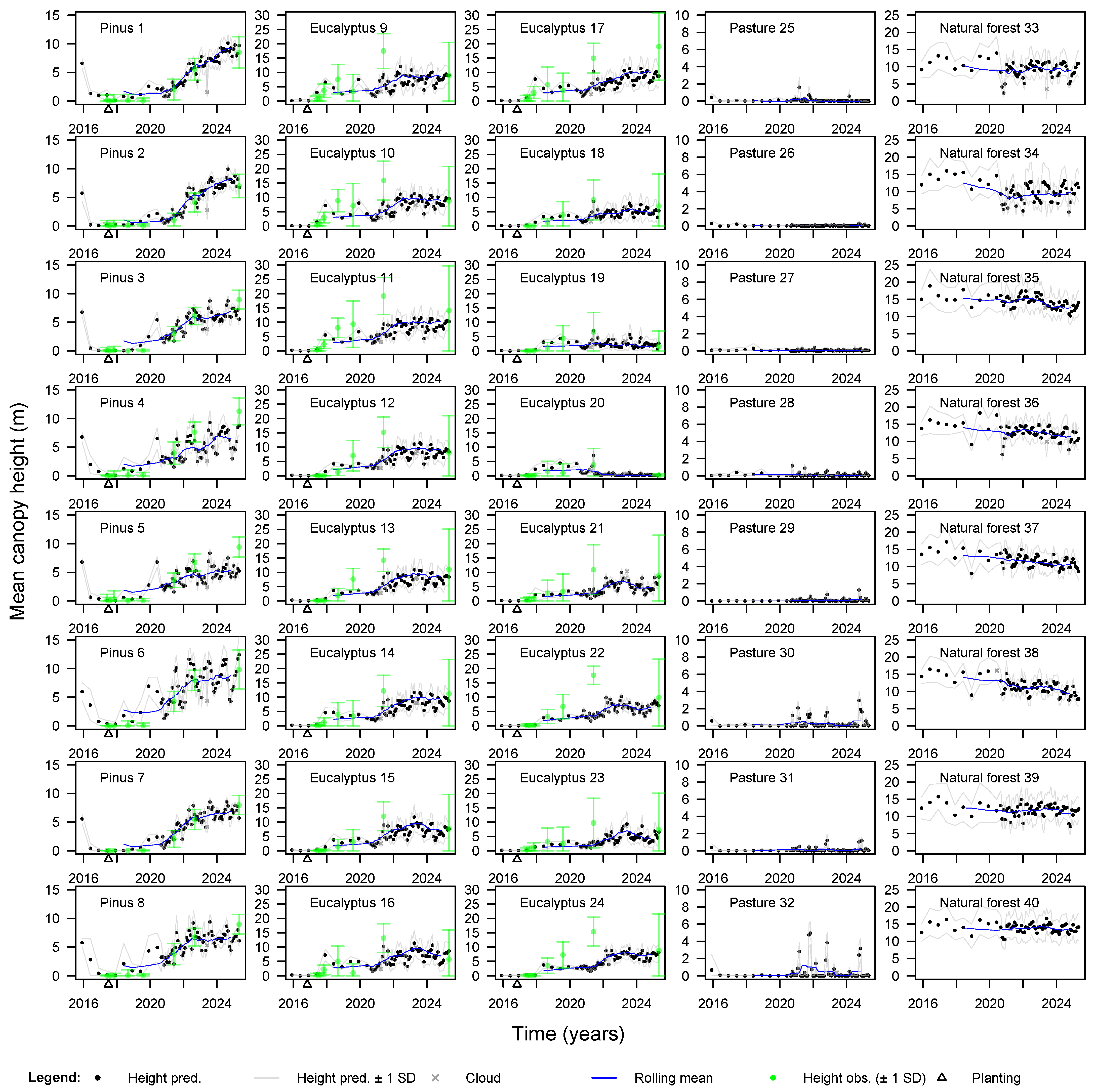Monitoring the Early Growth of Pinus and Eucalyptus Plantations Using a Planet NICFI-Based Canopy Height Model: A Case Study in Riqueza, Brazil
Abstract
1. Introduction
2. Materials and Methods
2.1. Study Site
2.2. Point Cloud Data
2.3. Planet NICFI Satellite Images of Riqueza, Santa Catarina—Brazil
2.4. Canopy Height U-Net Model
2.5. Predicting Canopy Height and Forest Cover
2.6. SRTM Model
2.7. Seasonal Height Analysis in Stable Forests
2.8. Statistical Analysis
2.9. Open Source Software and Tools
3. Results
3.1. Seasonal Variation in Canopy Height Estimates with Slope and Orientation
3.2. Geometric Distortion of the NICFI
3.3. Observed Canopy Height for the Plantations
3.4. Time Series of Parcel-Level Average Canopy Height
4. Discussion
4.1. Monitoring Height from Planet NICFI Images
4.2. Pinus and Eucalyptus Specific Performance
4.3. Performance of the Model in Control Areas
4.4. Seasonal Effects Artifacts and Geometric Distortions
4.5. Limitations of the Current Approach
5. Conclusions
Author Contributions
Funding
Data Availability Statement
Acknowledgments
Conflicts of Interest
References
- Griscom, B.W.; Adams, J.; Ellis, P.W.; Houghton, R.A.; Lomax, G.; Miteva, D.A.; Schlesinger, W.H.; Shoch, D.; Siikamäki, J.V.; Smith, P.; et al. Natural climate solutions. Proc. Natl. Acad. Sci. USA 2017, 114, 11645–11650. [Google Scholar] [CrossRef] [PubMed]
- Bastin, J.F.; Finegold, Y.; Garcia, C.; Mollicone, D.; Rezende, M.; Routh, D.; Zohner, C.M.; Crowther, T.W. The global tree restoration potential. Science 2019, 365, 76–79. [Google Scholar] [CrossRef] [PubMed]
- Cook-Patton, S.C.; Leavitt, S.M.; Gibbs, D.; Harris, N.L.; Lister, K.; Anderson-Teixeira, K.J.; Briggs, R.D.; Chazdon, R.L.; Crowther, T.W.; Ellis, P.W.; et al. Mapping carbon accumulation potential from global natural forest regrowth. Nature 2020, 585, 545–550. [Google Scholar] [CrossRef] [PubMed]
- Friedlingstein, P.; O’sullivan, M.; Jones, M.W.; Andrew, R.M.; Hauck, J.; Landschützer, P.; Le Quéré, C.; Li, H.; Luijkx, I.T.; Olsen, A.; et al. Global carbon budget 2024. Earth Syst. Sci. Data Discuss. 2024, 2024, 1–133. [Google Scholar] [CrossRef]
- UN Climate Summit. New York Declaration on Forests. 2014. Available online: https://forestdeclaration.org (accessed on 12 June 2025).
- IUCN. Bonn Challenge: Progress on Forest Landscape Restoration. 2020. Available online: https://www.bonnchallenge.org (accessed on 12 June 2025).
- Ellis, P.W.; Page, A.M.; Wood, S.; Fargione, J.; Masuda, Y.J.; Carrasco Denney, V.; Moore, C.; Kroeger, T.; Griscom, B.; Sanderman, J.; et al. The principles of natural climate solutions. Nat. Commun. 2024, 15, 547. [Google Scholar] [CrossRef]
- Almeida, D.; Broadbent, E.N.; Zambrano, A.M.A.; Wilkinson, B.E.; Ferreira, M.E.; Chazdon, R.; Meli, P.; Gorgens, E.; Silva, C.A.; Stark, S.C.; et al. Monitoring the structure of forest restoration plantations with a drone-lidar system. Int. J. Appl. Earth Obs. Geoinf. 2019, 79, 192–198. [Google Scholar] [CrossRef]
- Brancalion, P.H.; Chazdon, R.L. Beyond hectares: Four principles to guide reforestation in the context of tropical forest and landscape restoration. Restor. Ecol. 2017, 25, 491–496. [Google Scholar] [CrossRef]
- Smith, C.C.; Espírito-Santo, F.D.; Healey, J.R.; Young, P.J.; Lennox, G.D.; Ferreira, J.; Barlow, J. Secondary forests offset less than 10% of deforestation-mediated carbon emissions in the Brazilian Amazon. Glob. Change Biol. 2020, 26, 7006–7020. [Google Scholar] [CrossRef]
- Chazdon, R.L.; Broadbent, E.N.; Rozendaal, D.M.; Bongers, F.; Zambrano, A.M.A.; Aide, T.M.; Balvanera, P.; Becknell, J.M.; Boukili, V.; Brancalion, P.H.; et al. Carbon sequestration potential of second-growth forest regeneration in the Latin American tropics. Sci. Adv. 2016, 2, e1501639. [Google Scholar] [CrossRef]
- Lennox, G.D.; Gardner, T.A.; Thomson, J.R.; Ferreira, J.; Berenguer, E.; Lees, A.C.; Mac Nally, R.; Aragão, L.E.; Ferraz, S.F.; Louzada, J.; et al. Second rate or a second chance? Assessing biomass and biodiversity recovery in regenerating Amazonian forests. Glob. Change Biol. 2018, 24, 5680–5694. [Google Scholar] [CrossRef]
- Heinrich, V.H.; Dalagnol, R.; Cassol, H.L.; Rosan, T.M.; de Almeida, C.T.; Silva Junior, C.H.; Campanharo, W.A.; House, J.I.; Sitch, S.; Hales, T.C.; et al. Large carbon sink potential of secondary forests in the Brazilian Amazon to mitigate climate change. Nat. Commun. 2021, 12, 1785. [Google Scholar] [CrossRef]
- Heinrich, V.H.; Vancutsem, C.; Dalagnol, R.; Rosan, T.M.; Fawcett, D.; Silva-Junior, C.H.; Cassol, H.L.; Achard, F.; Jucker, T.; Silva, C.A.; et al. The carbon sink of secondary and degraded humid tropical forests. Nature 2023, 615, 436–442. [Google Scholar] [CrossRef]
- Poorter, L.; Craven, D.; Jakovac, C.C.; Van Der Sande, M.T.; Amissah, L.; Bongers, F.; Chazdon, R.L.; Farrior, C.E.; Kambach, S.; Meave, J.A.; et al. Multidimensional tropical forest recovery. Science 2021, 374, 1370–1376. [Google Scholar] [CrossRef]
- Hansen, M.C.; Potapov, P.V.; Moore, R.; Hancher, M.; Turubanova, S.A.; Tyukavina, A.; Thau, D.; Stehman, S.V.; Goetz, S.J.; Loveland, T.R.; et al. High-Resolution Global Maps of 21st-Century Forest Cover Change. Science 2013, 342, 850–853. [Google Scholar] [CrossRef]
- MapBiomas. Project MapBiomas, Collection 8.0 of Brazilian Land Cover & Use Map Series; Technical Report; MapBiomas: São Paulo, Brazil, 2024. [Google Scholar]
- Vancutsem, C.; Achard, F.; Pekel, J.F.; Vieilledent, G.; Carboni, S.; Simonetti, D.; Gallego, J.; Aragao, L.E.; Nasi, R. Long-term (1990–2019) monitoring of forest cover changes in the humid tropics. Sci. Adv. 2021, 7, eabe1603. [Google Scholar] [CrossRef]
- Wagner, F.H.; Dalagnol, R.; Silva-Junior, C.H.L.; Carter, G.; Ritz, A.L.; Hirye, M.C.M.; Ometto, J.P.H.B.; Saatchi, S. Mapping Tropical Forest Cover and Deforestation with Planet NICFI Satellite Images and Deep Learning in Mato Grosso State (Brazil) from 2015 to 2021. Remote Sens. 2023, 15, 521. [Google Scholar] [CrossRef]
- Dalagnol, R.; Wagner, F.H.; Galvão, L.S.; Braga, D.; Osborn, F.; da Conceição Bispo, P.; Payne, M.; Junior, C.S.; Favrichon, S.; Silgueiro, V.; et al. Mapping tropical forest degradation with deep learning and Planet NICFI data. Remote Sens. Environ. 2023, 298, 113798. [Google Scholar] [CrossRef]
- Csillik, O.; Kumar, P.; Mascaro, J.; O’Shea, T.; Asner, G.P. Monitoring tropical forest carbon stocks and emissions using Planet satellite data. Sci. Rep. 2019, 9, 17831. [Google Scholar] [CrossRef]
- de Jong, J.; Poorter, L.; de Jong, W.; Bongers, F.; Lohbeck, M.; Veenendaal, E.; Meave, J.A.; Jakovac, C.C.; Brancalion, P.H.; Amissah, L.; et al. Dissecting forest transition: Contribution of mature forests, second-growth forests and tree plantations to tree cover dynamics in the tropics. Land Use Policy 2025, 153, 107545. [Google Scholar] [CrossRef]
- Asner, G.P.; Mascaro, J. Mapping tropical forest carbon: Calibrating plot estimates to a simple LiDAR metric. Remote Sens. Environ. 2014, 140, 614–624. [Google Scholar] [CrossRef]
- Lim, K.; Treitz, P.; Wulder, M.; St-Onge, B.; Flood, M. LiDAR remote sensing of forest structure. Prog. Phys. Geogr. 2003, 27, 88–106. [Google Scholar] [CrossRef]
- De Almeida, D.R.A.; Broadbent, E.N.; Ferreira, M.P.; Meli, P.; Zambrano, A.M.A.; Gorgens, E.B.; Resende, A.F.; de Almeida, C.T.; Do Amaral, C.H.; Dalla Corte, A.P.; et al. Monitoring restored tropical forest diversity and structure through UAV-borne hyperspectral and lidar fusion. Remote Sens. Environ. 2021, 264, 112582. [Google Scholar] [CrossRef]
- de Almeida, D.R.; Vedovato, L.B.; Fuza, M.; Molin, P.; Cassol, H.; Resende, A.F.; Krainovic, P.M.; de Almeida, C.T.; Amaral, C.; Haneda, L.; et al. Remote sensing approaches to monitor tropical forest restoration: Current methods and future possibilities. J. Appl. Ecol. 2025, 62, 188–206. [Google Scholar] [CrossRef]
- Lang, N.; Schindler, K.; Wegner, J.D. Country-wide high-resolution vegetation height mapping with Sentinel-2. Remote Sens. Environ. 2019, 233, 111347. [Google Scholar] [CrossRef]
- Potapov, P.; Hansen, M.C.; Kommareddy, I.; Kommareddy, A.; Turubanova, S.; Pickens, A.; Adusei, B.; Tyukavina, A.; Ying, Q. Landsat analysis ready data for global land cover and land cover change mapping. Remote Sens. 2020, 12, 426. [Google Scholar] [CrossRef]
- Tolan, J.; Yang, H.I.; Nosarzewski, B.; Couairon, G.; Vo, H.V.; Brandt, J.; Spore, J.; Majumdar, S.; Haziza, D.; Vamaraju, J.; et al. Very high resolution canopy height maps from RGB imagery using self-supervised vision transformer and convolutional decoder trained on aerial lidar. Remote Sens. Environ. 2024, 300, 113888. [Google Scholar] [CrossRef]
- Song, H.; Zhang, X.; Hu, T.; Liu, J.; Xu, B. Seasonal Tree Height Dynamic Estimation Using Multi-source Remotely Sensed Data in Shenzhen. J. Remote Sens. 2025, 5, 0379. [Google Scholar] [CrossRef]
- Astola, H.; Seitsonen, L.; Halme, E.; Molinier, M.; Lönnqvist, A. Deep neural networks with transfer learning for forest variable estimation using sentinel-2 imagery in boreal forest. Remote Sens. 2021, 13, 2392. [Google Scholar] [CrossRef]
- Fayad, I.; Ciais, P.; Schwartz, M.; Wigneron, J.P.; Baghdadi, N.; de Truchis, A.; d’Aspremont, A.; Frappart, F.; Saatchi, S.; Pellissier-Tanon, A.; et al. Vision Transformers, a new approach for high-resolution and large-scale mapping of canopy heights. arXiv 2023, arXiv:2304.11487. [Google Scholar]
- Barreras, A.; Alanís de la Rosa, J.A.; Mayorga, R.; Cuenca, R.; Moreno-G, C.; Godínez, C.; Delgado, C.; Soriano-Luna, M.d.l.Á.; George, S.; Aldrete-Leal, M.I.; et al. Spatial predictions of tree density and tree height across Mexico forests using ensemble learning and forest inventory data. Ecol. Evol. 2023, 13, e10090. [Google Scholar] [CrossRef] [PubMed]
- Turubanova, S.; Potapov, P.; Hansen, M.C.; Li, X.; Tyukavina, A.; Pickens, A.H.; Hernandez-Serna, A.; Arranz, A.P.; Guerra-Hernandez, J.; Senf, C.; et al. Tree canopy extent and height change in Europe, 2001–2021, quantified using Landsat data archive. Remote Sens. Environ. 2023, 298, 113797. [Google Scholar] [CrossRef]
- Wagner, F.H.; Roberts, S.; Ritz, A.L.; Carter, G.; Dalagnol, R.; Favrichon, S.; Hirye, M.C.; Brandt, M.; Ciais, P.; Saatchi, S. Sub-meter tree height mapping of California using aerial images and LiDAR-informed U-Net model. Remote Sens. Environ. 2024, 305, 114099. [Google Scholar] [CrossRef]
- Wagner, F.H.; Dalagnol, R.; Carter, G.; Hirye, M.C.; Gill, S.; Takougoum, L.B.S.; Favrichon, S.; Keller, M.; Ometto, J.P.; Alves, L.; et al. High Resolution Tree Height Mapping of the Amazon Forest using Planet NICFI Images and LiDAR-Informed U-Net Model. arXiv 2025, arXiv:2501.10600. [Google Scholar]
- Schwartz, M.; Ciais, P.; Ottlé, C.; De Truchis, A.; Vega, C.; Fayad, I.; Brandt, M.; Fensholt, R.; Baghdadi, N.; Morneau, F.; et al. High-resolution canopy height map in the Landes forest (France) based on GEDI, Sentinel-1, and Sentinel-2 data with a deep learning approach. Int. J. Appl. Earth Obs. Geoinf. 2024, 128, 103711. [Google Scholar] [CrossRef]
- LeCun, Y.; Bengio, Y.; Hinton, G. Deep learning. Nature 2015, 521, 436–444. [Google Scholar] [CrossRef]
- Planet Team. Planet Application Program Interface: In Space for Life on Earth; Planet Team: San Francisco, CA, USA, 2017. [Google Scholar]
- Pandey, P.; Kington, J.; Kanwar, A.; Curdoglo, M. Addendum to Planet Basemaps. Product Specifications; NICFI Basemaps. v02; NICFI Basemaps: Oslo, Norway, 2021. [Google Scholar]
- Ronneberger, O.; Fischer, P.; Brox, T. U-Net: Convolutional Networks for Biomedical Image Segmentation. arXiv 2015. [Google Scholar] [CrossRef]
- CTrees.org. REDD+AI: Tree Cover Loss and Degradation from Logging, Fire and Roads in Tropical Forests—v 1.0. 2024. Available online: https://ctrees.org/REDDAI (accessed on 5 August 2025).
- da Rosa, P.A.; Breunig, F.M.; de Almeida, C.M.; Balbinot, R. Dinâmica de fragmentos florestais no noroeste do Rio Grande do Sul. Geogr. Ensino Pesqui. 2017, 21, 177–189. [Google Scholar] [CrossRef]
- Turnbull, J.W. Eucalypt plantations. New For. 1999, 17, 37–52. [Google Scholar] [CrossRef]
- Alvares, C.A.; Stape, J.L.; Sentelhas, P.C.; Gonçalves, J.d.M.; Sparovek, G. Köppen’s climate classification map for Brazil. Meteorol. Z. 2013, 22, 711–728. [Google Scholar] [CrossRef]
- Beck, H.E.; Zimmermann, N.E.; McVicar, T.R.; Vergopolan, N.; Berg, A.; Wood, E.F. Present and future Köppen-Geiger climate classification maps at 1-km resolution. Sci. Data 2018, 5, 180214. [Google Scholar] [CrossRef] [PubMed]
- Mouselimis, L. PlanetNICFI: Processing of the ‘Planet NICFI’ Satellite Imagery Using R; R Package Version 1.0.4; Planet Labs Inc.: San Francisco, CA, USA, 2022. [Google Scholar]
- Planet. Planet Imagery Product Specifications; Planet Labs: San Francisco, CA, USA, 2021; p. 91. [Google Scholar]
- Farr, T.G.; Rosen, P.A.; Caro, E.; Crippen, R.; Duren, R.; Hensley, S.; Kobrick, M.; Paller, M.; Rodriguez, E.; Roth, L.; et al. The shuttle radar topography mission. Rev. Geophys. 2007, 45, 1–33. [Google Scholar] [CrossRef]
- R Core Team. R: A Language and Environment for Statistical Computing; R Foundation for Statistical Computing: Vienna, Austria, 2025. [Google Scholar]
- GDAL/OGR Contributors. GDAL/OGR Geospatial Data Abstraction Software Library; Open Source Geospatial Foundation: Beaverton, OR, USA, 2025. [Google Scholar]
- Hijmans, R.J. terra: Spatial Data Analysis. R Package Version 1.7-46. 2023. Available online: https://CRAN.R-project.org/package=terra (accessed on 9 June 2025).
- Hijmans, R.J. raster: Geographic Data Analysis and Modeling. R Package Version 3.0-2. 2019. Available online: https://CRAN.R-project.org/package=raster (accessed on 9 June 2025).
- Pebesma, E.; Bivand, R. Spatial Data Science: With Applications in R; Chapman and Hall/CRC: London, UK, 2023. [Google Scholar] [CrossRef]
- Pebesma, E. Simple Features for R: Standardized Support for Spatial Vector Data. R J. 2018, 10, 439–446. [Google Scholar] [CrossRef]
- Zeileis, A.; Grothendieck, G. zoo: S3 Infrastructure for Regular and Irregular Time Series. J. Stat. Softw. 2005, 14, 1–27. [Google Scholar] [CrossRef]
- Chollet, F. Keras. 2015. Available online: https://keras.io (accessed on 5 August 2025).
- Allaire, J.; Chollet, F. keras: R Interface to ‘Keras’. R Package Version 2.13.0.9000. 2016. Available online: https://tensorflow.rstudio.com/ (accessed on 9 June 2025).
- Allaire, J.; Tang, Y. tensorflow: R Interface to ‘TensorFlow’. R Package Version 2.13.0. 2023. Available online: https://CRAN.R-project.org/package=tensorflow (accessed on 9 June 2025).
- Abadi, M.; Agarwal, A.; Barham, P.; Brevdo, E.; Chen, Z.; Citro, C.; Corrado, G.S.; Davis, A.; Dean, J.; Devin, M.; et al. TensorFlow: Large-Scale Machine Learning on Heterogeneous Systems. 2015. Available online: https://www.tensorflow.org/ (accessed on 5 August 2025).
- QGIS Development Team. QGIS Geographic Information System; Open Source Geospatial Foundation: Beaverton, OR, USA, 2025. [Google Scholar]
- Pinto, C.B.; Marques, R.; Dalmaso, C.A.; de Souza Kulmann, M.S.; Deliberali, I.; Schumacher, M.V.; de Oliveira Junior, J.C. Relationship between edaphoclimatic attributes and productivity of loblolly pine (Pinus taeda L.) in southern Brazil. For. Ecol. Manag. 2023, 544, 121162. [Google Scholar] [CrossRef]
- IBÁ. Relatorio Anual 2022; Relatorio; Industria Brasileira de Arvores: São Paulo, Brazil, 2022. [Google Scholar]
- Laclau, J.P.; Almeida, J.C.; Gonçalves, J.L.M.; Saint-Andre, L.; Ventura, M.; Ranger, J.; Moreira, R.M.; Nouvellon, Y. Influence of nitrogen and potassium fertilization on leaf lifespan and allocation of above-ground growth in Eucalyptus plantations. Tree Physiol. 2009, 29, 111–124. [Google Scholar] [CrossRef]
- Da Silva, R.M.L.; Hakamada, R.E.; Bazani, J.H.; Otto, M.S.G.; Stape, J.L. Fertilization Response, Light Use, and Growth Efficiency in Eucalyptus Plantations across Soil and Climate Gradients in Brazil. Forests 2016, 7, 117. [Google Scholar] [CrossRef]
- Lisi, C.S.; Fo, M.T.; Botosso, P.C.; Roig, F.A.; Maria, V.R.; Ferreira-Fedele, L.; Voigt, A.R. Tree-ring formation, radial increment periodicity, and phenology of tree species from a seasonal semi-deciduous forest in southeast Brazil. Iawa J. 2008, 29, 189–207. [Google Scholar] [CrossRef]
- Di Francescantonio, D.; Villagra, M.; Goldstein, G.; Campanello, P.I. Leaf phenology and water-use patterns of canopy trees in Northern Argentinean subtropical forests. Tree Physiol. 2018, 38, 1841–1854. [Google Scholar] [CrossRef]
- Pennington, R.T.; Lavin, M.; Oliveira-Filho, A. Woody plant diversity, evolution, and ecology in the tropics: Perspectives from seasonally dry tropical forests. Annu. Rev. Ecol. Evol. Syst. 2009, 40, 437–457. [Google Scholar] [CrossRef]
- Leite, P.F.; Klein, R.M. Vegetação. Geogr. Bras. Reg. Sul 1990, 2, 113–150. [Google Scholar]
- Schaaf, C.B.; Gao, F.; Strahler, A.H.; Lucht, W.; Li, X.; Tsang, T.; Strugnell, N.C.; Zhang, X.; Jin, Y.; Muller, J.P.; et al. First operational BRDF, albedo nadir reflectance products from MODIS. Remote Sens. Environ. 2002, 83, 135–148. [Google Scholar] [CrossRef]






| Forest Type | Field Date | n | Meanfield | Meanmodel | MAE | RMSE | Bias | t | p-Value |
|---|---|---|---|---|---|---|---|---|---|
| Pinus | 1 June 2017 | 8 | 0.07 | 0.27 | 0.23 | 0.35 | 0.20 | 1.86 | 0.105 |
| Pinus | 1 August 2017 | 8 | 0.01 | 0.27 | 0.26 | 0.41 | 0.26 | 2.11 | 0.073 |
| Pinus | 1 November 2017 | 8 | 0.10 | 0.10 | 0.12 | 0.16 | 0.00 | 0.07 | 0.945 |
| Pinus | 1 September 2018 | 8 | 0.07 | 0.68 | 0.62 | 0.77 | 0.62 | 3.50 | 0.010 |
| Pinus | 1 August 2019 | 8 | 0.06 | 1.05 | 0.99 | 1.11 | 0.99 | 5.19 | 0.001 |
| Pinus | 1 June 2021 | 8 | 2.97 | 3.60 | 0.77 | 1.01 | 0.64 | 2.15 | 0.069 |
| Pinus | 1 September 2022 | 8 | 6.28 | 6.05 | 0.79 | 1.05 | −0.23 | −0.59 | 0.575 |
| Pinus | 1 May 2025 | 8 | 8.99 | 7.44 | 2.00 | 2.52 | −1.55 | −2.06 | 0.079 |
| Eucalyptus | 1 June 2017 | 16 | 0.21 | 0.67 | 0.46 | 0.69 | 0.46 | 3.43 | 0.004 |
| Eucalyptus | 1 August 2017 | 16 | 0.30 | 0.67 | 0.40 | 0.62 | 0.37 | 2.89 | 0.011 |
| Eucalyptus | 1 November 2017 | 16 | 1.10 | 3.16 | 2.06 | 2.61 | 2.06 | 4.98 | 0.000 |
| Eucalyptus | 1 September 2018 | 16 | 3.76 | 3.21 | 1.94 | 2.44 | −0.55 | −0.90 | 0.383 |
| Eucalyptus | 1 August 2019 | 16 | 4.65 | 3.48 | 2.34 | 3.03 | −1.17 | −1.62 | 0.127 |
| Eucalyptus | 1 June 2021 | 16 | 13.00 | 4.65 | 8.32 | 8.96 | −8.32 | −9.64 | <0.001 |
| Eucalyptus | 1 May 2025 | 16 | 8.62 | 7.24 | 1.93 | 2.97 | −1.38 | −2.03 | 0.061 |
Disclaimer/Publisher’s Note: The statements, opinions and data contained in all publications are solely those of the individual author(s) and contributor(s) and not of MDPI and/or the editor(s). MDPI and/or the editor(s) disclaim responsibility for any injury to people or property resulting from any ideas, methods, instructions or products referred to in the content. |
© 2025 by the authors. Licensee MDPI, Basel, Switzerland. This article is an open access article distributed under the terms and conditions of the Creative Commons Attribution (CC BY) license (https://creativecommons.org/licenses/by/4.0/).
Share and Cite
Wagner, F.H.; Breunig, F.M.; Balbinot, R.; Silva, E.A.; Soares, M.C.; Kramm, M.A.; Hirye, M.C.M.; Carter, G.; Dalagnol, R.; Hagen, S.C.; et al. Monitoring the Early Growth of Pinus and Eucalyptus Plantations Using a Planet NICFI-Based Canopy Height Model: A Case Study in Riqueza, Brazil. Remote Sens. 2025, 17, 2718. https://doi.org/10.3390/rs17152718
Wagner FH, Breunig FM, Balbinot R, Silva EA, Soares MC, Kramm MA, Hirye MCM, Carter G, Dalagnol R, Hagen SC, et al. Monitoring the Early Growth of Pinus and Eucalyptus Plantations Using a Planet NICFI-Based Canopy Height Model: A Case Study in Riqueza, Brazil. Remote Sensing. 2025; 17(15):2718. https://doi.org/10.3390/rs17152718
Chicago/Turabian StyleWagner, Fabien H., Fábio Marcelo Breunig, Rafaelo Balbinot, Emanuel Araújo Silva, Messias Carneiro Soares, Marco Antonio Kramm, Mayumi C. M. Hirye, Griffin Carter, Ricardo Dalagnol, Stephen C. Hagen, and et al. 2025. "Monitoring the Early Growth of Pinus and Eucalyptus Plantations Using a Planet NICFI-Based Canopy Height Model: A Case Study in Riqueza, Brazil" Remote Sensing 17, no. 15: 2718. https://doi.org/10.3390/rs17152718
APA StyleWagner, F. H., Breunig, F. M., Balbinot, R., Silva, E. A., Soares, M. C., Kramm, M. A., Hirye, M. C. M., Carter, G., Dalagnol, R., Hagen, S. C., & Saatchi, S. (2025). Monitoring the Early Growth of Pinus and Eucalyptus Plantations Using a Planet NICFI-Based Canopy Height Model: A Case Study in Riqueza, Brazil. Remote Sensing, 17(15), 2718. https://doi.org/10.3390/rs17152718








